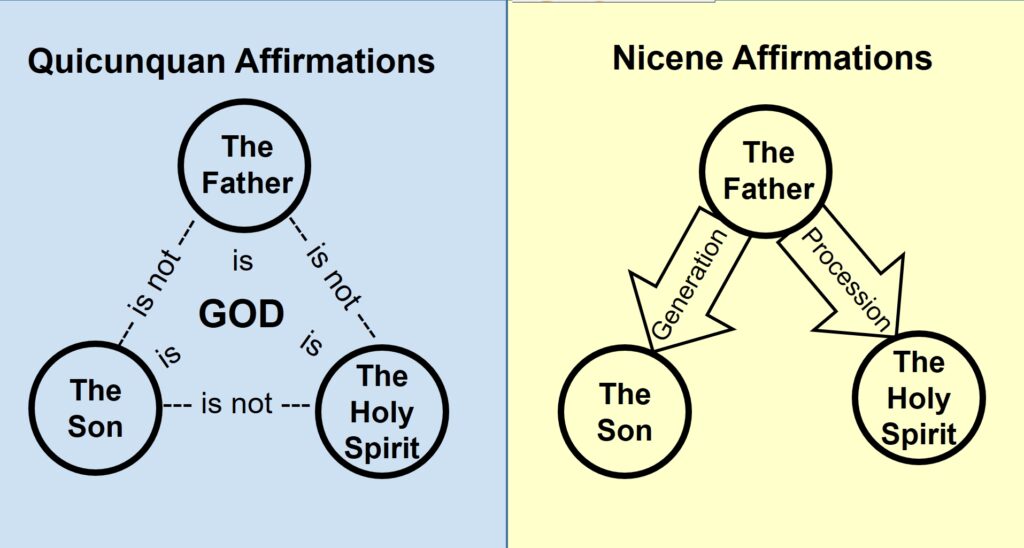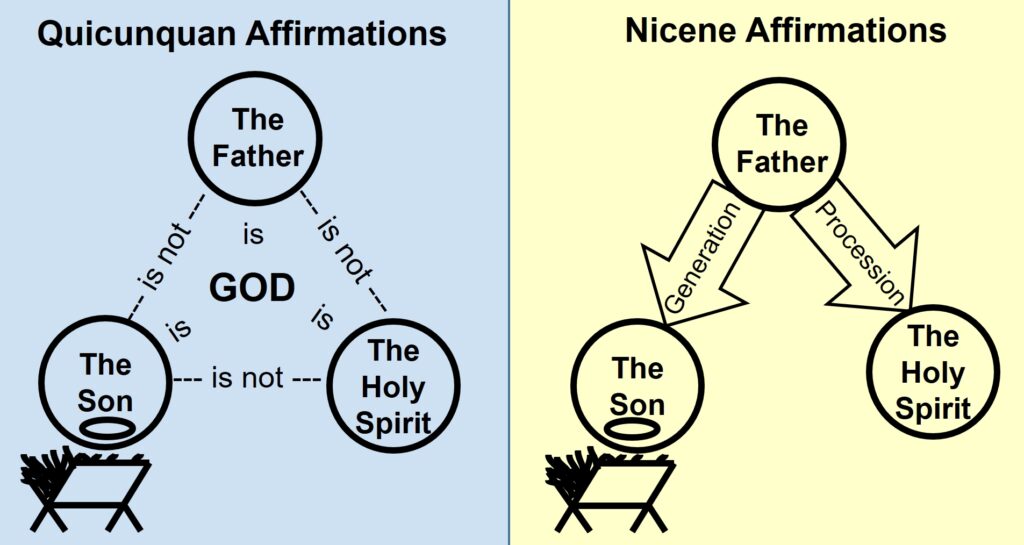A scene from The Canterbury Psalter (12th century)
Blog
Of the Father’s Love Begotten
When you consider the Trinitarian background of the incarnation, you usually summon to mind one of two possible mental frameworks. First is the “one God in three persons” framework, which involves thinking of how each person of the Trinity is fully God, but none are each other. The second option is the “Father begets the Son and spirates the Spirit” option, which involves thinking of how each person of the Trinity is related to each other through irreversible relations of origin.
I’ve nicknamed these two styles of trinitarian schemas the Quicunquan and Nicene styles, after the two creeds that best encapsulate them (Quicunquan being an intentionally odd term for the so-called Athanasian Creed, drawing on its first word in Latin).
Here are diagrams:

The two frameworks do not contradict each other, any more than the creeds they are named for do. You need to believe both creeds to succeed in being an informed trinitarian, and you’ll refer to both frameworks when thinking about the doctrine. But notice how different they are in what they set forth and draw attention to: the Christological aspect of the Athanasian Creed (“Quicunquan style”) affirms that the Son is God, but is not the Father. The Christological aspect of the Nicene Creed affirms that the Son is eternally begotten, or generated, from the Father. You might call the Quicunquan a logical map, and the Nicene a relational one.
The strongest contrast is here: What does each framework hold out as the thing we should say about the Father and the Son? One says a mere negative, “the Father is not the Son; they are distinct,” while the other proposes a relation: “the Father eternally begets the Son.”
Remember, I’m not asking you to choose between the two. I’m about to commend the Nicene framework as being the most valuable for considering the incarnation, but that’s not a denial of the Athanasian Creed’s main point. We can’t speak meaningfully about the Father begetting the Son (Nicene style) if we somehow think the Father just is the Son. So it turns out that the rather cold, analytical Quicunquan affirmation that the Father is not the Son is doing a lot of work for us.
Here’s the application to the incarnation. Take your mental map of the doctrine of the Trinity and drop the doctrine of the incarnation into it, or rather, place the incarnation at the point in the mental map where the person of the Son is. Here, I’ve done it for you, using a stick-figure manger, crowned by a halo, as the sign of the incarnation:

The Quicunquan style, as a diagram of the sturdy old shield of the Trinity, allows us to say something like, “the one who became incarnate is God, but is not the Father or the Spirit.” Or we might say, “the one who became incarnate has the divine essence, but is a distinct person from Father and Spirit.” True statements! But you get the sense that they are sort of hedging around the key point. Who is this child?
But the Nicene style lets you go straight to that point: this one, born of Mary, is the one eternally begotten of God the Father. There is a personal continuity between the Son’s eternal generation from the Father, by virtue of which he is who he is (the Son), and is what he is (God, having the divine nature as from the Father).
If you’re trying to align your thoughts about the incarnation with your background trinitarian framework, you are likely to find that the Quicunquan framework is of limited effectiveness. The Nicene framework, with its emphasis on the Father-Son relation of eternal generation, is much better suited to join up the various parts of Christian doctrine. The long line from the eternal begetting of the Son by the Father, to the temporal mission of the Son from the Father, is right there. It lends a profound, truly divine resonance to the personal reality of the Son’s mission to us, for us and our salvation.
About This Blog

Fred Sanders is a theologian who tried to specialize in the doctrine of the Trinity, but found that everything in Christian life and thought is connected to the triune God.


